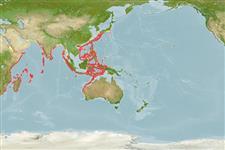分類 / Names
共通名の | 類義語 | Catalog of Fishes(部類, 種) | ITIS | CoL | WoRMS | Cloffa
>
Scombriformes (Mackerels) >
Gempylidae (Snake mackerels)
Etymology: Neoepinnula: Greek, neos = new + Latin ex = outside + Latin, diminutive of pinna = spiny (Ref. 45335).
Environment: milieu / climate zone / depth range / distribution range
生態学
海 底生の漂泳性; 深さの範囲 200 - 570 m (Ref. 6181). Deep-water; 37°N - 31°S, 32°E - 140°E (Ref. 6181)
Indo-West Pacific: off East Africa (Kenya to Natal, South Africa), Saya de Malha Bank, Arabian Sea; eastern North Indian Ocean, Flores, Banda, Arafura Sea, Sulawesi and Sulu seas, off Ryukyu Islands and southern Japan. Reported from Fiji and Tuvalu (Ref. 12596).
サイズ / 重さ / 年齢
Maturity: Lm ? range ? - ? cm
Max length : 30.0 cm SL オス/雌雄の選別がない; (Ref. 6181)
背面の脊椎 (合計): 17; 背鰭 (合計): 17-20; 肛門の骨 3; 臀鰭: 17 - 19. There are two lateral lines on the sides, both originating from above the upper angle of the gill opening. Overall color is greenish brown to dark brown. The buccal and branchial cavities are usually black.
Feeds on small fishes, crustaceans and cephalopods (Ref. 30573). Matures at about 15 cm SL.
Life cycle and mating behavior
成熟 | 繁殖 | 放精 | 卵 | 生産力 | 幼生
Nakamura, I. and N.V. Parin, 1993. FAO Species Catalogue. Vol. 15. Snake mackerels and cutlassfishes of the world (families Gempylidae and Trichiuridae). An annotated and illustrated catalogue of the snake mackerels, snoeks, escolars, gemfishes, sackfishes, domine, oilfish, cutlassfishes,. scabbardfishes, hairtails, and frostfishes known to date. FAO Fish. Synop. 125(15):136 p. (Ref. 6181)
Human uses
水産業: 食糧水産
より多くの情報
参考文献水産養殖水産養殖の紹介緊張遺伝子のElectrophoreses遺伝病気行列NutrientsMass conversion
用具
特記事項
XMLをダウンロードして下さい
インターネットの情報源
Estimates based on models
Preferred temperature (Ref.
123201): 9.2 - 15.7, mean 11.9 °C (based on 148 cells).
Phylogenetic diversity index (Ref.
82804): PD
50 = 0.7500 [Uniqueness, from 0.5 = low to 2.0 = high].
Bayesian length-weight: a=0.00269 (0.00152 - 0.00477), b=3.05 (2.89 - 3.21), in cm total length, based on LWR estimates for this species & (Sub)family-body (Ref.
93245).
栄養段階 (Ref.
69278): 4.2 ±0.58 se; based on food items.
回復力 (Ref.
120179): 高い, 15か月以下の倍増期間の最小個体群 (Preliminary K or Fecundity.).
Fishing Vulnerability (Ref.
59153): Low to moderate vulnerability (27 of 100).
Nutrients (Ref.
124155): Calcium = 25.9 [12.2, 61.1] mg/100g; Iron = 0.387 [0.168, 0.844] mg/100g; Protein = 17 [15, 19] %; Omega3 = 0.458 [0.226, 0.917] g/100g; Selenium = 17.2 [6.8, 38.0] μg/100g; VitaminA = 18.7 [3.9, 86.0] μg/100g; Zinc = 0.423 [0.291, 0.643] mg/100g (wet weight); based on
nutrient studies.
